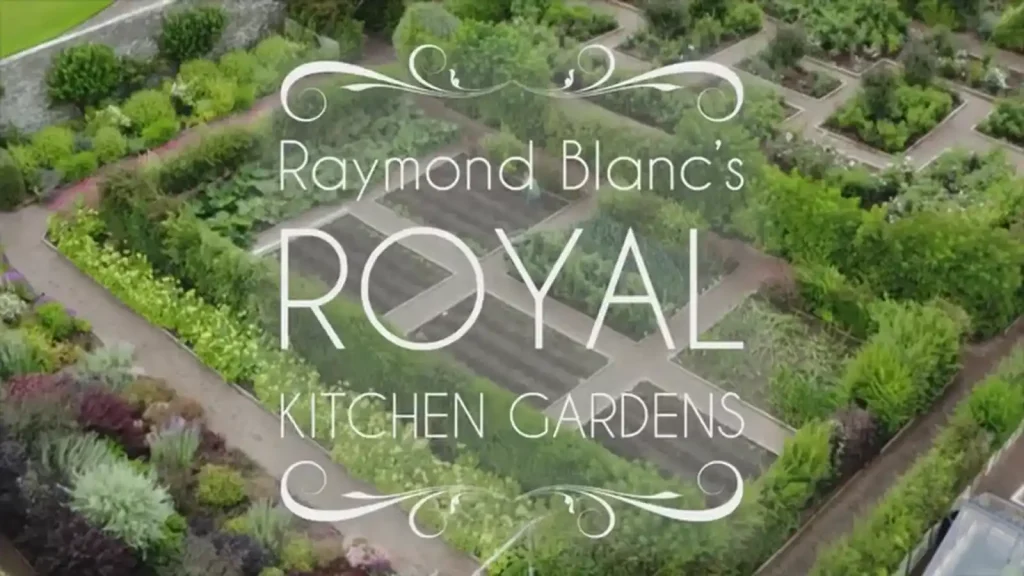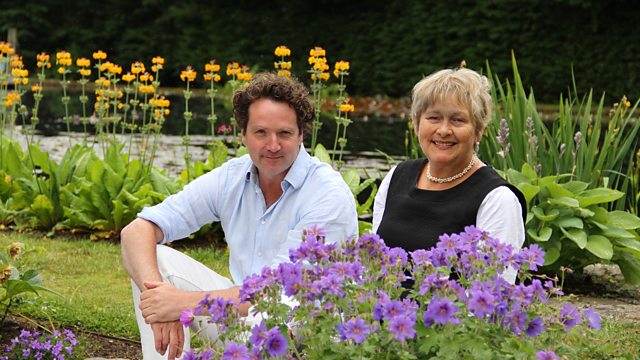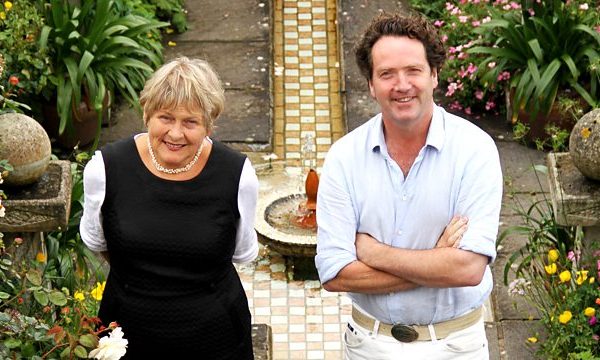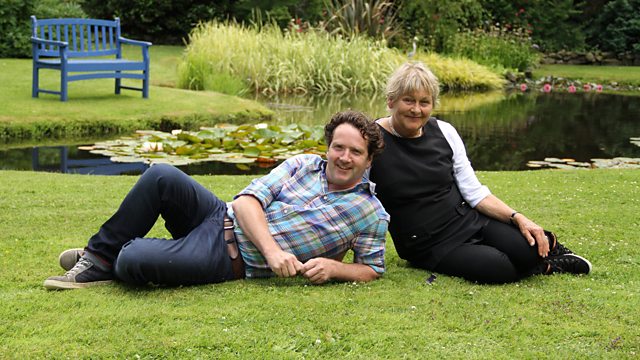Raymond Blanc’s Royal Kitchen Gardens episode 6: Constructed in the 16th century, the splendid Hampton Court Palace served as the residence of King Henry VIII and his six wives. This historical gem, nestled on the picturesque banks of the River Thames, continues to captivate visitors with its rich past and breathtaking architecture.
In the captivating documentary series “Raymond Blanc’s Royal Kitchen Gardens,” celebrated chef Raymond Blanc explores the grandeur of this magnificent estate in Episode 6. Blanc, renowned for his expertise and culinary excellence, delves into the heart of Hampton Court’s horticultural legacy, focusing on one of its most illustrious and longstanding inhabitants: the Great Vine.
Planted in 1768 by the famous gardener Lancelot ‘Capability’ Brown, the Great Vine holds the record as the largest grapevine in the world, a testament to the palace’s enduring commitment to botanical excellence. Throughout the episode, Blanc not only examines the historical significance and the horticultural marvels of the vine but also showcases its practical contributions to today’s culinary world.
The episode reaches a culinary climax as Chef Blanc, drawing inspiration from the palace’s verdant gardens, prepares a sumptuous dish of asparagus adorned with chervil butter. This dish is not just a tribute to the fresh produce grown in the royal gardens but also a nod to the sophisticated flavors that can be coaxed from simple, well-grown ingredients.
“Raymond Blanc’s Royal Kitchen Gardens” offers viewers an intimate look at the intertwining of historical cultivation and modern gastronomy, brought to life through the eyes of a chef deeply reverent of nature’s bounty housed within the walls of one of Britain’s most storied landmarks.
Raymond Blanc’s Royal Kitchen Gardens episode 6
A Royal Culinary Journey
Raymond Blanc’s Invitation to Explore Royal Kitchen Gardens
Step into a world where culinary artistry meets regal splendor. Renowned chef Raymond Blanc invites us on an extraordinary journey through the lush, productive gardens of Britain’s most spectacular royal palaces. Like a master storyteller weaving a tapestry of flavors and history, Blanc guides us through these verdant sanctuaries, each brimming with edible treasures fit for a king.
Imagine strolling alongside Blanc as he uncovers the secrets of these centuries-old gardens. His eyes sparkle with childlike wonder as he examines each leaf, herb, and vegetable. “Oh, they look so beautiful,” he exclaims, his passion for fresh, seasonal produce evident in every word. This isn’t just a tour; it’s an immersive experience that tantalizes all the senses.
The Legacy of King Charles III’s Passion for Sustainable Food
At the heart of this royal culinary exploration lies a modern monarch’s vision. King Charles III, long before ascending the throne, championed a cause close to Blanc’s own heart: sustainable, organic farming. The king’s dedication to this noble pursuit has transformed these historic grounds into living laboratories of eco-friendly cultivation.
His Majesty’s commitment goes beyond mere gardening. It’s a royal crusade for food provenance and homegrown produce that resonates deeply with chefs like Blanc. “His majestic knowledge of food, of garden, how to grow a garden… is immense,” Blanc notes, his voice tinged with admiration. This shared passion forms a bridge between past and present, linking ancient royal traditions with modern sustainable practices.
As we embark on this gastronomic adventure, we’re not just observers but participants in a legacy centuries in the making. From Hampton Court’s Great Vine to the herb-laden beds of forgotten royal favorites, each garden tells a story of innovation, perseverance, and royal influence on British cuisine. Prepare to be transported through time, guided by the expert hand of Raymond Blanc, as we uncover the delicious secrets nestled within these regal grounds.
Hampton Court Palace’s Horticultural Marvels
The Great Vine: A 250-Year-Old Living Legend
Picture yourself standing before a colossal grapevine, its gnarled trunk as thick as a small car, its branches stretching over 30 meters long. This isn’t a figment of your imagination; it’s the Great Vine at Hampton Court Palace, a living testament to centuries of royal horticulture.
Planted in 1768 by the celebrated landscape architect Lancelot ‘Capability’ Brown, this Black Hamburg grapevine has witnessed the reign of numerous monarchs. Its longevity is nothing short of miraculous. While most vines live for 50 to 100 years, this green giant has thrived for over two and a half centuries, making it not just the oldest known grapevine but also the largest in the world.
History and Care of the World’s Largest Grapevine
The Great Vine’s survival is a testament to the dedication of generations of royal gardeners. Each year, it’s nourished with a whopping 10 tonnes of manure, ensuring its roots remain well-fed. This careful attention to detail mirrors the vine’s royal heritage, where no expense was spared in cultivating the finest produce for the monarch’s table.
Pruning such a mammoth plant is no small feat. The gardeners must strike a delicate balance between leaves and fruit, ensuring optimal growth and grape production. This meticulous care echoes the precision of a royal ceremony, each snip of the pruning shears as purposeful as a courtier’s bow.
Harvesting and Distribution of Royal Grapes
Come September, the Great Vine bursts into a spectacle of purple abundance. The harvest, lasting several weeks, is a time of excitement and anticipation. In days gone by, these grapes were exclusively for royal consumption. In fact, each bunch was individually numbered to prevent any unauthorized sampling!
Today, however, the bounty of the Great Vine is shared with the public. Visitors to Hampton Court Palace can purchase these historic grapes, savoring a taste that has delighted monarchs for centuries. It’s a delicious democracy, where everyone can enjoy a morsel of royal luxury.
The Walled Garden: A Time Capsule of Culinary Heritage
Step through the gates of Hampton Court’s Walled Garden, and you’re transported to a world where time seems to stand still. This one-acre haven is more than just a pretty space; it’s a living museum of horticultural history, meticulously recreated to reflect its 18th-century glory.
The garden’s formal grid layout, with its geometric beds and paths, is a feast for the eyes. But it’s more than mere aesthetics at play here. This design is a window into the structured mindset of Georgian gardeners, where order and symmetry reigned supreme.
Recreating 18th-Century Garden Layouts
Bringing this garden back to life was no small feat. The restoration team pored over contemporary 18th-century paintings, using them as blueprints to recreate the garden’s original splendor. It’s like stepping into a living, breathing artwork, where you can touch, smell, and even taste the history.
Each bed tells a story of the past. Here, you might find heritage vegetables that have long disappeared from supermarket shelves. There, you’ll discover fruit varieties that were once the height of fashion but have since fallen into obscurity. It’s a delicious journey through time, every plant a chapter in Britain’s culinary history.
Exploring the Historic Herb Beds
At the heart of the Walled Garden lie the historic herb beds, a fragrant tapestry of medicinal, culinary, and aromatic plants. These aren’t just any herbs; they’re the same varieties that would have graced royal tables centuries ago.
Wander through these beds, and you’ll encounter familiar faces like rosemary and thyme. But you’ll also meet forgotten friends like hyssop, once used to mask unpleasant odors in Tudor times, or Good King Henry, aptly nicknamed “poor man’s asparagus.” Each plant has a tale to tell, a secret use, or a royal connection waiting to be discovered.
From Garden to Table – Royal Recipes Unveiled
Raymond Blanc’s Asparagus with Chervil Butter
As the sun-dappled kitchen of Hampton Court Palace comes into view, Raymond Blanc’s eyes sparkle with anticipation. He’s about to transform simple ingredients into a dish fit for royalty. With a flourish, he presents his creation: Asparagus with Chervil Butter, a symphony of spring flavors that would make even the most discerning monarch’s taste buds sing.
The Art of Preparing White and Green Asparagus
Blanc’s nimble fingers dance over the asparagus spears, both white and green. “These,” he says, holding up the pale stalks, “are the same family as the green, but grown under the earth.” He explains how the lack of sunlight prevents chlorophyll development, resulting in a sweeter, more delicate flavor.
With the precision of a surgeon, he peels the white asparagus, revealing tender flesh beneath. The green spears, he leaves untouched, their vibrant color a promise of earthy goodness. As he works, Blanc shares a secret: “The white takes three times longer to cook than the green. Patience, my friends, is the key to perfection.”
Creating a Simple Yet Elegant Chervil Sauce
Now, Blanc turns his attention to the sauce, a deceptively simple concoction that elevates the dish to royal heights. “Chervil,” he muses, “is such an underappreciated herb.” His hands move swiftly, chopping the delicate leaves with practiced ease.
In a small pan, shallots sizzle gently in butter, their pungent aroma softening into sweetness. Blanc adds the chervil, its slightly aniseed flavor perfuming the air. A splash of water, a squeeze of lemon, and the sauce comes together in a velvety emulsion. “No stock needed,” Blanc declares proudly. “My mother always used water, and who am I to argue with such wisdom?”
Executive Chef Neil Roster’s Marinated Beetroot Dish
Stepping into the palace’s café kitchen, we meet Executive Chef Neil Roster. His canvas today? A vibrant array of beetroots, fresh from Hampton Court’s own gardens. Roster’s eyes light up as he describes his creation: Marinated Beetroot with Goats Curd and Truffle Honey Dressing.
Roasting Techniques for Maximum Flavor
Roster’s approach to beetroot is nothing short of revelatory. “Roasting,” he explains, “is the key to unlocking their full potential.” He tosses the ruby-red globes with thyme, rock salt, and a drizzle of olive oil. A splash of water goes into the roasting tin, a chef’s trick to create steam and prevent drying.
As the beetroots roast, their earthy aroma fills the kitchen. Roster shares his secret: “Two to three hours at 160°C. Patience yields perfection.” When they emerge, their skins slip off like silk, revealing jewel-toned flesh bursting with concentrated flavor.
Composing a Colorful Plate with Garden-Fresh Ingredients
With the roasted beetroots cooled, Roster begins his culinary ballet. He shaves raw golden beets paper-thin, their sunny hue a striking contrast to the deep red of their roasted cousins. A quick marinade in sherry vinegar and lemon juice adds brightness and begins a gentle pickling process.
Next comes a creamy dollop of goat’s curd, its tanginess a perfect foil for the sweet beets. Roster pipes it onto the plate with the precision of a pastry chef. The finishing touch? A drizzle of truffle honey dressing, its earthy sweetness tying all the elements together in a harmonious dance of flavors.
The Royal Chocolate Legacy
As our culinary journey through Hampton Court continues, we stumble upon a sweet secret: the palace’s rich chocolate history. In the historic kitchens, interpretation guide Mark unveils the mysteries of Georgian chocolate-making, a process as intricate as any royal ceremony.
Georgian Chocolate-Making Process
Mark gestures to a collection of unroasted cacao beans, their journey from tropical shores to royal kitchens a testament to chocolate’s luxury status. “These,” he explains, “would be roasted on-site.” The process, he demonstrates, involves careful grinding of the roasted nibs on a heated stone, known as a saddle-quern.
As Mark works, the air fills with the intoxicating aroma of melting chocolate. He explains how the heat, kept at blood temperature, ensures the perfect melding of cocoa solids and butter. It’s a far cry from modern chocolate-making, but the results are undeniably luxurious.
John Knott’s Wine Chocolate: A Royal Favorite
The pinnacle of Georgian chocolate indulgence comes in the form of John Knott’s wine chocolate, a recipe dating back to 1723 and a favorite of George I. Mark unveils the ingredients: half a pint of cherry or port, a generous helping of chocolate, and an eyebrow-raising amount of sugar.
As the concoction simmers, its rich aroma transports us back in time. One can almost imagine Georgian courtiers sipping this decadent brew, its warmth and sweetness a perfect antidote to drafty palace halls. Mark offers a taste, and suddenly, we’re all feeling a bit more regal.
Recreating Royal Delights at Home
Raymond’s Mamemblant’s Chocolate Mousse
As the sun sets on our royal culinary adventure, Raymond Blanc invites us into his personal realm of sweet indulgence. With a twinkle in his eye, he unveils the secret to a dessert that has graced countless royal tables: Mamemblant’s Chocolate Mousse. This isn’t just any chocolate mousse; it’s a recipe steeped in tradition, passed down through generations of French cuisine.
The Simplicity of a Four-Ingredient Dessert
Blanc’s approach to this classic dessert is refreshingly straightforward. “Everyone loves chocolate,” he begins, his voice warm with nostalgia. “But this recipe, ah, it’s probably the most delicious, the silkiest, and the simplest from Mamemblant.” With theatrical flourish, he reveals just four ingredients: chocolate, lemon juice, sugar, and egg whites.
The magic, Blanc explains, lies in the quality and balance of these simple components. He opts for a rich, 70% cocoa chocolate, its deep flavor a foundation for the ethereal texture to come. The lemon juice, a surprising addition, serves a dual purpose: preventing the egg whites from curdling and enhancing the overall flavor profile.
Techniques for Achieving the Perfect Texture
As Blanc begins to craft his mousse, he shares the secrets to achieving that coveted silky texture. “It’s very therapeutic, you know,” he muses, whipping the egg whites with practiced ease. The transformation is mesmerizing; glossy peaks form, promising a light, airy finish to the dessert.
The chef’s movements are precise yet relaxed as he folds the chocolate into the egg whites. “You must be gentle,” he advises, “to keep all that beautiful air inside.” It’s a delicate dance, one that requires patience and a keen eye. Too much mixing, and the mousse will deflate; too little, and it won’t be uniform.
Tips for Growing and Using Fresh Herbs
Inspired by the lush herb gardens of Hampton Court, Blanc shares his wisdom on cultivating a personal herb oasis. “Herbs,” he declares, “are the soul of any dish.” With the right knowledge, even the smallest windowsill can become a fragrant haven of culinary potential.
Blanc recommends starting with hardy perennials like rosemary and thyme. These Mediterranean natives thrive in sunny spots and well-drained soil, perfect for novice gardeners. For those with limited space, he suggests vertical gardening techniques, transforming walls into living tapestries of flavor.
But growing is only half the battle. Blanc emphasizes the importance of proper harvesting and storage. “Cut herbs in the morning,” he advises, “when their essential oils are most concentrated.” He demonstrates how to store them, wrapped gently in damp paper towels and refrigerated, to maintain freshness for days.
Adapting Palace Recipes for Modern Kitchens
The grandeur of royal kitchens may seem a world away from our modest home setups, but Blanc assures us that the essence of palace cuisine can be captured in any kitchen. The key, he insists, lies in understanding the principles behind the recipes rather than slavishly following every detail.
Take, for instance, the roasted beetroot dish from Hampton Court. While we may not have access to heritage varieties, Blanc encourages experimentation with locally available beets. “The spirit of the dish,” he explains, “is in celebrating the earthy sweetness of the vegetable.” He suggests pairing roasted beets with creamy goat cheese and a drizzle of honey as a simplified homage to the palace recipe.
For those intimidated by elaborate sauces, Blanc offers a comforting perspective. “Remember,” he says with a wink, “even royal chefs started somewhere.” He recommends mastering basic techniques like emulsification, which can elevate simple ingredients to regal status. A quick lesson in creating a velvety vinaigrette becomes a gateway to more complex palace-inspired dressings.
F.A.Q. Raymond Blanc’s Royal Kitchen Gardens episode 6
Q.: What historical significance does Hampton Court Palace hold in British history?
A.: Constructed in the 16th century, Hampton Court Palace is renowned as the residence of King Henry VIII and his six wives. This palace not only showcases breathtaking architecture but also serves as a monument to Tudor history, reflecting the opulence and political intrigue of the era. Its location along the River Thames further enhances its historical allure, making it a pivotal site in British royal history.
Q.: Who is Raymond Blanc, and what is his connection to Hampton Court Palace?
A.: Raymond Blanc is a celebrated chef known for his culinary expertise and passion for organic gardening. In his documentary series, “Raymond Blanc’s Royal Kitchen Gardens,” he explores Hampton Court Palace’s horticultural legacy, particularly focusing on its historic gardens and the Great Vine, blending his culinary skills with the rich historical tapestry of the palace.
Q.: Can you tell me more about the Great Vine at Hampton Court Palace?
A.: The Great Vine at Hampton Court Palace is recognized as the largest grapevine in the world. Planted in 1768 by the famed gardener Lancelot ‘Capability’ Brown, it epitomizes the palace’s long-standing commitment to botanical excellence. This venerable vine continues to produce grapes and serves as a living symbol of the palace’s rich botanical history.
Q.: What type of culinary experiences does Raymond Blanc showcase in his documentary at Hampton Court?
A.: In his documentary, Raymond Blanc highlights the integration of fresh produce from the royal gardens into sophisticated dishes. For instance, he prepares asparagus with chervil butter, showcasing how simple, fresh ingredients can be transformed into exquisite culinary creations, emphasizing the blend of historical cultivation with contemporary gastronomy.
Q.: How can visitors experience the legacy of Hampton Court Palace’s gardens today?
A.: Visitors to Hampton Court Palace can explore the extensive gardens, which include the famous maze, the Great Vine, and restored royal kitchen gardens. These areas not only offer a glimpse into the historical and horticultural practices of the past but also provide a sensory experience through seasonal displays and the availability of produce like the grapes from the Great Vine during harvest season.
Conclusion: The Timeless Appeal of Royal Gastronomy
The Intersection of History, Sustainability, and Culinary Arts
As we draw the curtains on our royal culinary journey, we find ourselves at a unique crossroads where the past, present, and future of gastronomy converge. The regal kitchen gardens we’ve explored are not mere relics of a bygone era; rather, they stand as living testaments to the enduring principles of sustainable, seasonal cooking.
These gardens, with their centuries-old vines and meticulously recreated herb beds, offer more than just a glimpse into history. They serve as a blueprint for modern sustainable practices, echoing King Charles III’s long-standing commitment to organic farming and environmental stewardship. In an age of fast food and convenience, these royal gardens remind us of the importance of knowing where our food comes from and the value of patience in cultivation.
The chefs we’ve met along the way, from Raymond Blanc to Hampton Court’s own Neil Roster, demonstrate how historical techniques can be seamlessly blended with contemporary culinary innovation. Their creations – whether it’s a simple asparagus dish with chervil butter or a complex beetroot salad – pay homage to tradition while pushing the boundaries of modern gastronomy. This delicate balance between honoring the past and embracing the future is what keeps royal cuisine relevant and exciting in the 21st century.
Carrying Forward Royal Culinary Traditions in Modern Times
The question now is: how do we, as everyday food enthusiasts, carry these royal culinary traditions into our own kitchens and lives? The answer lies not in attempting to recreate palatial grandeur, but in embracing the core principles that have guided royal kitchens for centuries.
Firstly, we can adopt the royal approach to seasonality. Just as the Great Vine at Hampton Court produces its bounty in late summer, we too can learn to appreciate and utilize ingredients at their peak. This not only ensures the best flavor but also aligns our eating habits with the natural rhythms of the earth – a truly regal practice in its sustainability.
Secondly, we can embrace the art of patience in our cooking. The Georgian chocolate-making process we witnessed, with its careful roasting and grinding of cacao beans, teaches us that sometimes, the most rewarding culinary experiences come from taking our time. In our fast-paced world, there’s something revolutionary about slow, mindful food preparation.
Lastly, we can take inspiration from the royal kitchen gardens in our own growing endeavors. Whether it’s a windowsill herb garden or a full-fledged vegetable patch, cultivating even a small portion of our own food connects us to a tradition that has nourished monarchs and subjects alike for centuries.
As we close this chapter on royal gastronomy, let’s remember that these culinary traditions are not relics to be admired from afar, but living practices to be embraced and adapted. By incorporating these timeless principles into our daily lives, we not only elevate our own culinary experiences but also become part of a grand, ongoing narrative of food, history, and sustainability. In doing so, we ensure that the legacy of royal gastronomy continues to flourish, nourishing both body and soul for generations to come.




